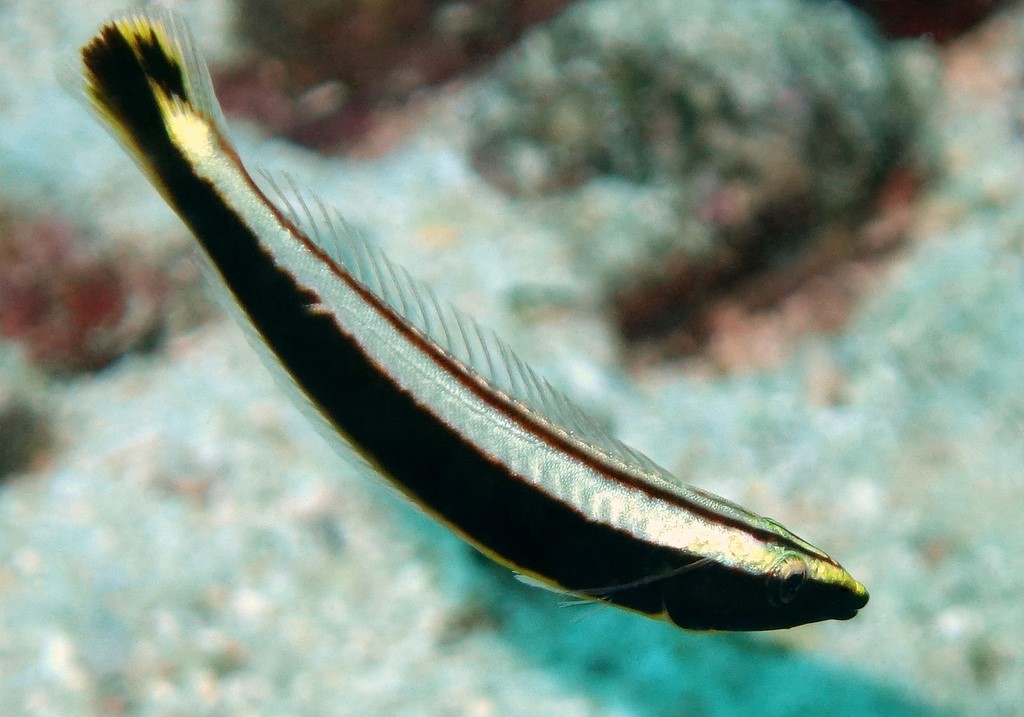HOLOGYMNOSUS ANNULATUS - (LACEPEDE, 1801)
Picture courtesy of: Alain Daoulas
Actinopterygii (Gigaclass) > Actinopteri (Class) > Teleostei (Subclass) > Labriformes (Order) > Labroidei (Suborder) > Labridae (Family) > Hologymnosus (Genus)
Colombine annelée, Labre annelé, Ringed slender wrasse, Ring wrasse, Ringed wrasse, Pacific ringed wrasse, Gestreifter Hechtlippfisch, Colombina anelada, Colombina anillada, Namerabera, ナメラベラ, 环带细鳞盔鱼, 環紋全裸鸚鯛,
Synonymes
Coris elongata (Günther, 1862)
Coris semipartita (Günther, 1862)
Hemigumnosus semidiscus (Lacepède, 1801)
Hologymnos annulatus (Lacepède, 1801)
Hologymnosus semidiscus (Lacepède, 1801)
Labrus annulatus (Lacepède, 1801)
Labrus semidiscus (Lacepède, 1801)
-------------------------
Description
Dorsal spines (total): 9; Dorsal soft rays (total): 12, the spines thin and flexible; Anal spines: 3; Anal soft rays: 12; Pectoral fin rays: 13; Lateral line scales: 100-118; Gill rakers: 18-23; Body elongate, depth: 3.3-5.1 in SL, deeper-bodied with growth; Pectoral fins not short: 1.65-1.9 in HL. Pelvic fins short; Dorsal- and anal-fin spines and rays uniformly high; Head scaleless; Two pairs of canine teeth anteriorly in jaws; No canine at corner of mouth; Caudal fin slightly rounded in juveniles, emarginate in adults, the concavity of large males about 5 in Head Length. Max. length: 40.0 cm TL, common length: 34.0 cm TL. Depth range: 8 - 40 m.
Etymology
Hologymnosus: from Greek, hólos = whole, full + from Greek, gymnos = naked. Described as lacking “any easily visible scales”. In actuality, its scales are small but its head is scaleless.
annulatus: from Latin, annulus = ring. Referring to ~19 narrow transverse bands on sides of adults, which appear to encircle the body and meet the bands on the opposite side (they do not).
Original description: Labrus annulatus Lacepède, 1801 - Type locality: Mauritius, Mascarenes, southwestern Indian Ocean.
Distribution
Red Sea; Indo-West Pacific: KwaZulu-Natal (South Africa), East Africa, Socotra (Yemen), Seychelles, Comoros, Madagascar and Mascarenes (La Réunion, Mauritius, Rodrigues), east to Pitcairn, north to southern Japan, south to northern Australia, New Caledonia and Rapa (French Polynesia).
Biology
Found on coral reefs and rocky substrates on offshore reef slopes. Juveniles generally solitary. Feeds primarily on small fishes, also on crustaceans. Pelagic spawner. Aquarium fish.
Similar species
Malacanthus latovittatus (Lacepède, 1801) - Reported from New Caledonia - Link to the species (here). Juvenile Hologymnosus annulatus very closely resemble juvenile Malacanthus latovittatus.
Last update: 6, April 2023
Actinopterygii (Gigaclass) > Actinopteri (Class) > Teleostei (Subclass) > Labriformes (Order) > Labroidei (Suborder) > Labridae (Family) > Hologymnosus (Genus)
Colombine annelée, Labre annelé, Ringed slender wrasse, Ring wrasse, Ringed wrasse, Pacific ringed wrasse, Gestreifter Hechtlippfisch, Colombina anelada, Colombina anillada, Namerabera, ナメラベラ, 环带细鳞盔鱼, 環紋全裸鸚鯛,
Synonymes
Coris elongata (Günther, 1862)
Coris semipartita (Günther, 1862)
Hemigumnosus semidiscus (Lacepède, 1801)
Hologymnos annulatus (Lacepède, 1801)
Hologymnosus semidiscus (Lacepède, 1801)
Labrus annulatus (Lacepède, 1801)
Labrus semidiscus (Lacepède, 1801)
-------------------------
Description
Dorsal spines (total): 9; Dorsal soft rays (total): 12, the spines thin and flexible; Anal spines: 3; Anal soft rays: 12; Pectoral fin rays: 13; Lateral line scales: 100-118; Gill rakers: 18-23; Body elongate, depth: 3.3-5.1 in SL, deeper-bodied with growth; Pectoral fins not short: 1.65-1.9 in HL. Pelvic fins short; Dorsal- and anal-fin spines and rays uniformly high; Head scaleless; Two pairs of canine teeth anteriorly in jaws; No canine at corner of mouth; Caudal fin slightly rounded in juveniles, emarginate in adults, the concavity of large males about 5 in Head Length. Max. length: 40.0 cm TL, common length: 34.0 cm TL. Depth range: 8 - 40 m.
Color
- Juveniles pale yellow, with broad dark brown stripe on lower sides and head, covering lips and lower two-thirds of eye, extending onto caudal fin; Dark red to black line from front of snout along back above lateral line.
- Females usually pale grey-brown to olivaceous (but may be bluish, greenish or pinkish grey), with 17-22 dark bars on body, narrower than interspaces; Small bicolored spot on opercular membrane; Black spot on side of lips, larger on lower; Median fins dark brown with white margins, caudal fin with large white crescent.
- Males green, sometimes shading to blue ventrally, with 17-22 purplish red bars, often with narrow pale yellowish bar across body above anal-fin origin; Head with green bands radiating from eye, one forward onto snout expanding broadly to large quadrangular area; Lips pale blue to blue-green with large spot or band of deep blue or purple; caudal fin purplish blue, upper and lower margins pale blue, with pale rear crescent.
- The Pacific form has a pale peduncular area when in nuptial mode.
Etymology
Hologymnosus: from Greek, hólos = whole, full + from Greek, gymnos = naked. Described as lacking “any easily visible scales”. In actuality, its scales are small but its head is scaleless.
annulatus: from Latin, annulus = ring. Referring to ~19 narrow transverse bands on sides of adults, which appear to encircle the body and meet the bands on the opposite side (they do not).
Original description: Labrus annulatus Lacepède, 1801 - Type locality: Mauritius, Mascarenes, southwestern Indian Ocean.
Distribution
Red Sea; Indo-West Pacific: KwaZulu-Natal (South Africa), East Africa, Socotra (Yemen), Seychelles, Comoros, Madagascar and Mascarenes (La Réunion, Mauritius, Rodrigues), east to Pitcairn, north to southern Japan, south to northern Australia, New Caledonia and Rapa (French Polynesia).
Biology
Found on coral reefs and rocky substrates on offshore reef slopes. Juveniles generally solitary. Feeds primarily on small fishes, also on crustaceans. Pelagic spawner. Aquarium fish.
Similar species
Malacanthus latovittatus (Lacepède, 1801) - Reported from New Caledonia - Link to the species (here). Juvenile Hologymnosus annulatus very closely resemble juvenile Malacanthus latovittatus.
Last update: 6, April 2023
